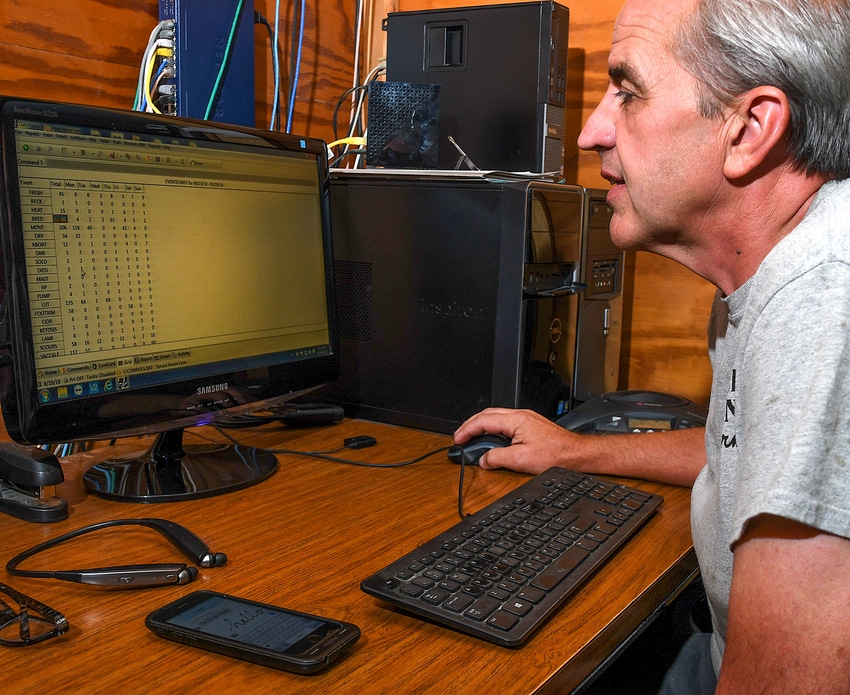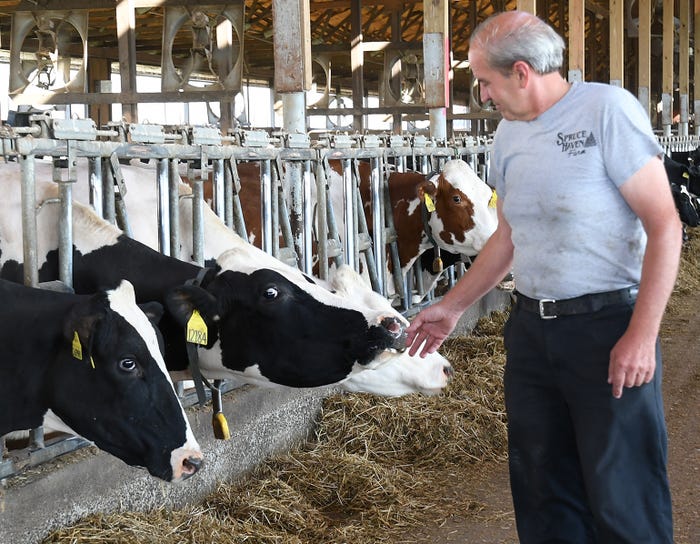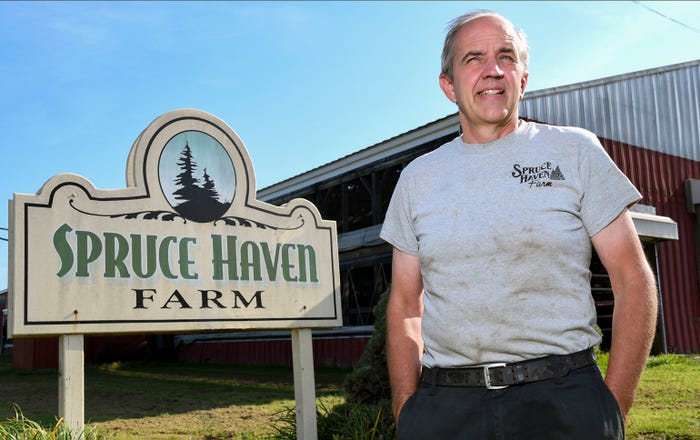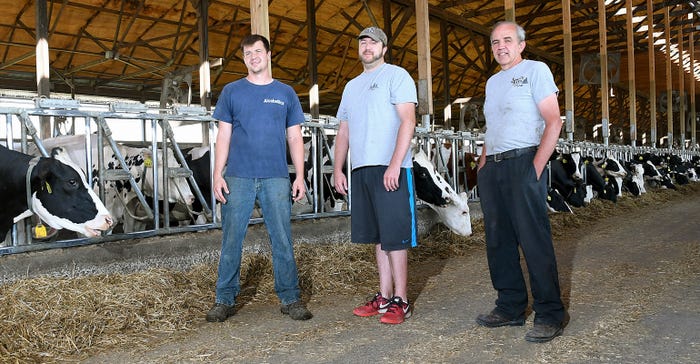September 20, 2018

Applying a precision selective dry cow therapy algorithm at Spruce Haven Farm has helped cut its dry cow treatment by 75% without losing milk production or increasing culling or clinical mastitis.
The farm’s success is setting a new standard for the dairy industry.
"We had been told for a long time that blanket treatment was needed, but after we lost a couple of dry cows that had never had mastitis during lactation and were treated, we questioned that," says Doug Young, an owner of the farm in Union Springs, N.Y.
The algorithm was developed by Cornell professor Daryl Nydam, director of Quality Milk Production Services.
Blanket treatment with antimicrobial drugs has traditionally been used to treat existing infections or to potentially prevent new infections during the dry period. Young has suspected, however, that, despite strict hygienic practices, the teat canal treatment to prevent mastitis was simultaneously introducing pathogens.
 SELECTIVE TREATMENT: Doug Young with some of the dry cows at Spruce Haven Farm. A new algorithm developed by Cornell helps identify problem dry cows for treatment.
SELECTIVE TREATMENT: Doug Young with some of the dry cows at Spruce Haven Farm. A new algorithm developed by Cornell helps identify problem dry cows for treatment.

To find a better way to protect his cows, Young called Nydam, who is based in Ithaca, N.Y.
"The ultimate goal of administering intramammary antibiotics at the beginning of the dry period is to treat existing subclinical infections, and to prevent new infections that may be acquired or maintained in the dry period and become clinical post-partum," Nydam says. "That said, not every cow is subclinical and needs treatment, especially as mastitis management on modern dairies has become much better."
He and veterinarian Amy Vasquez with the New York State Veterinary Diagnostic Lab at Cornell used DairyComp 305 and Dairy Herd Improvement Association test-day data to develop a culture-independent algorithm for selectively identifying cows for antibiotic treatment. The algorithm helps sort infected cows from the noninfected.
Research shows that a 65% reduction in treatment is typical on farms that institute selective dry cow treatment. The cost savings for reducing antimicrobial use in the initial study was estimated at $6 per cow across the entire herd.
A cow is considered low risk if its last somatic cell count was equal to or less than 200,000; the average of its last three SCC results was also equal to or less than 200,000; it had no clinical mastitis at dry off; and it had zero or only one incident of clinical mastitis in its most-current lactation.
"Low-risk cows are unlikely to benefit from treatment at dry-off. Historically, more cows were higher risk and benefitted from the antibiotics leading to a blanket management approach. Today, on progressive farms like Spruce Haven, approximately 65% or more of the cows are low risk," Nydam says.
Best practices include good recordkeeping
The herd at Spruce Haven Farm includes 1,750 cows and about 250 dry cows on any given day. Computerized recordkeeping was readily available for input into the new algorithm. The farm’s somatic cell count herd average is routinely below 180,000.
 PROGRESSIVE MIND: Doug Young has always questioned the need for blanket treatment of dry cows for mastitis and other issues.
PROGRESSIVE MIND: Doug Young has always questioned the need for blanket treatment of dry cows for mastitis and other issues.

Over the course of nine months, Nydam and Vasquez tested 600 cows at the farm. Low-risk cows received intramammary antimicrobial treatment and teat sealant, or only teat sealant. Outcomes were compared in the next lactation. High-risk cows were all treated with an FDA-approved intramammary antibiotic.
"We changed our procedure to follow the selective algorithm for a more controlled treatment plan and reduced the number of cows treated without any negative effect," Young says. "That represents a savings in money, time and labor; reduces the risk of infection to our cows; and lessens the opportunity for antibiotic resistance buildup."
Selective dry cow treatment should be applied in tandem with proper udder care, milking procedures, milking parlor equipment maintenance and overall good hygienic practices.
As farms adopt the use of the treatment protocol, Nydam stresses, "It is very important to have contagious mastitis that is caused by Staph aureus and Strep agalactiae under control across the herd before using SDCT.
"General mastitis prevention measures should be soundly implemented to increase the opportunity for success with SDCT. Clinical mastitis detection and treatment should be systematically deployed, and the bulk tank SCC should be less than 300,000 before you start."
It also requires good record keeping that includes individual cow somatic cell count tracking, recording of clinical mastitis and other factors.
On-farm innovation
Spruce Haven Farms’ business model includes an on-farm research center.
Current projects include working toward better capture of the market value of the farm’s methane digester energy recovery system; developing direct farm-to-consumer beverage production with expectation of delivering its first FDA-approved, high-CLA, lactose-free, no-refrigeration-needed product in 2019; and searching for funding to engineer and commercialize its patented technology for the distribution of digested manure nutrients on growing corn to increase yield while decreasing nitrogen and phosphorus loss.
Precision stewardship
For Young, instituting data-driven treatment fits his philosophy of good stewardship.
"We want to replenish the resources we have been given. We are glad to have played a part in making this precision treatment possible as a way to not only reduce costs but to produce more of a high-quality product with less impact," he says. "This industry-leading success is a step forward for the dairy industry to respond to consumer interest in reducing antibiotic use."
 FAMILY AFFAIR: The Spruce Haven Farm family includes Doug Young, right, with his sons Luke, center, and Dustin.
FAMILY AFFAIR: The Spruce Haven Farm family includes Doug Young, right, with his sons Luke, center, and Dustin.

The development of the selective dry cow treatment protocol was funded in part through the New York Farm Viability Institute.
For more information, contact Nydam at 607-253-4391 or [email protected].
Dunn writes from her farm in Mannsville, N.Y.
About the Author(s)
You May Also Like




